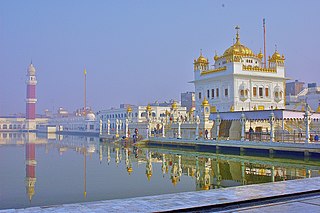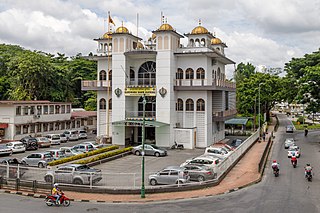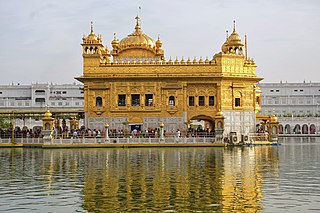The following outline is provides an overview of Sikhism,or Sikhi.

The Ardās is a set prayer in Sikhism. It is a part of worship service in a Gurdwara,daily rituals such as the opening the Guru Granth Sahib for prakash or closing it for sukhasan in larger Gurdwaras,closing of congregational worship in smaller Gurdwaras,rites-of-passages such as with the naming of child or the cremation of a loved one,daily prayer by devout Sikhs and any significant Sikh ceremonies.

Tarn Taran Sahib is a city in the Majha region of the state of Punjab,in northern India. It is the district headquarters and hosts the municipal council of Tarn Taran district. Gurdwara Sri Tarn Taran Sahib,a prominent Sikh shrine,is located in the central part of the city.

Gurdwara Sri Guru Singh Sabha Southall (SGSS) is a Sikh Gurdwara situated on Guru Nanak Road and Park Avenue,Southall,in the London Borough of Ealing. It is the largest Sikh temple in London. Building work at the Havelock Road site commenced in March 2000 and the Gurdwara opened on Sunday 30 March 2003,in order to accommodate Southall's growing Sikh community. The Gurdwara cost £17.5 million to build. It was funded by donations from members of the local Sikh community.

The Ontario Gurdwaras Committee is an independent,non-profit organization representing over 20 gurdwaras—Sikh places of worship—located in Ontario and Quebec. It organizes such events as the annual Khalsa Day parade in Mississauga.
Ravidassia or the Ravidas Panth is a religion based on the teachings of Guru Ravidas. It was considered a sect within Sikhism until 2009. However,some Ravidassias continue to maintain Sikh religious practices,including the reverence of the Guru Granth Sahib as their focal religious text,wearing Sikh articles of faith (5Ks),and appending Singh or Kaur to their names.
Rehat refers to the rules and traditions which govern the unique Sikh lifestyle and determines correct Sikh orthodoxy and orthopraxy. The Sikh Rehit Maryada is a code of conduct and conventions for Sikhism. The final version of the Rehat Maryada was controversially approved by the Shiromani Gurdwara Parbandhak Committee,Amritsar in 1945. The Rehat Maryada was created to provide guidance to Sikhs on practical and functional aspects of daily life,including the operations of Sikh Gurdwaras,and religious practices to foster cohesion throughout the community. Rehitnāma is a Punjabi term that refers to a genre of Sikh religious literature which expounds upon specifiying an approved way of life for a Sikh.

The Chief Khalsa Diwan or Chief Khalsa Diwan Charitable Society is a Sikh organisation that is the central organization of various Singh Sabhas spread across Punjab,India. Unlike the Shiromani Gurudwara Prabandhak Committee,the C.K.D. is an apolitical body and only concerns itself with religious,educational and cultural issues. The organization originally controlled Sikh religious and educational concerns and was an advocate of Sikh political rights,though it presently is mostly limited to educational spheres. It was the main council of Sikhs until the birth of more radical organizations,such as the Central Sikh League,the S.G.P.C.,and the Akali Dal.

The Khalsa Diwan Society Vancouver is a Sikh gurdwara organization in Vancouver,British Columbia,Canada.

The Delhi Sikh Gurdwara Management Committee (DSGMC) is organization in India responsible for the management of Gurdwaras, Sikh places of worship in the City of Delhi. It also manages various educational institutions,hospitals,old age homes,libraries and other charitable institutions in Delhi. It is headquartered in Gurdwara Rakab Ganj Sahib,near Parliament House. Currently,the president of DSGMC is Harmeet Singh Kalka.

German Sikhs are a growing religious minority in Germany. The majority of German Sikhs have their roots from the Punjab,India with the remaining coming from the Afghan Sikh community or through conversion. The number of Sikhs is estimated to be between 25,000. Germany had the fifth highest Sikh population in Europe after United Kingdom (524,000),Italy (220,000),Portugal (35,000) and Spain (26,000).

English Sikhs number over 520,000 people and account for 0.9% of England's population in 2021,forming the country's fourth-largest religious group. In 2006 there were 352 gurdwaras in England. The largest Sikh populations in the U.K. are in the West Midlands and Greater London.

Malaysian Sikhs are known to be the fourth largest Malaysian Indian ethnic group. It is estimated that there are around 100,000 Sikhs in Malaysia.

The Golden Temple (also known as the Harmandir Sahib,or the Darbār Sahib,is a gurdwara located in the city of Amritsar,Punjab,India. It is the pre-eminent spiritual site of Sikhism. It is one of the holiest sites in Sikhism,alongside the Gurdwara Darbar Sahib Kartarpur in Kartarpur,and Gurdwara Janam Asthan in Nankana Sahib.

The Singh SabhāMovement,also known as the Singh SabhāLehar,was a Sikh movement that began in Punjab in the 1870s in reaction to the proselytising activities of Christians,Hindu reform movements and Muslims. The movement was founded in an era when the Sikh Empire had been dissolved and annexed by the British,the Khalsa had lost its prestige,and mainstream Sikhs were rapidly converting to other religions. The movement's aims were to "propagate the true Sikh religion and restore Sikhism to its pristine glory;to write and distribute historical and religious books of Sikhs;and to propagate Gurmukhi Punjabi through magazines and media." The movement sought to reform Sikhism and bring back into the Sikh fold the apostates who had converted to other religions;as well as to interest the influential British officials in furthering the Sikh community. At the time of its founding,the Singh Sabha policy was to avoid criticism of other religions and political matters.
A takht,or taḵẖat,literally means a throne or seat of authority and is a spiritual and temporal centre of Sikhism. There are five takhts,which are five gurudwaras that have a very special significance for the Sikh community. Three are located in Punjab whilst the remaining two are located outside of it.

Sikhism prohibits idolatry,in accordance with mainstream Khalsa norms and the teachings of the Sikh Gurus,a position that has been accepted as orthodox.

Sikhism in China is a minority religion in the People's Republic of China. Sikhism originated from the Punjab region of the northern Indian subcontinent.
























